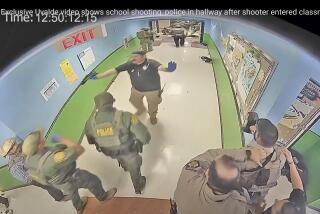Educators Look for Answers to Violence : Schools: Classroom danger is on the rise, experts tell gathering, and suburbia is not immune as 150,000 crimes are committed each year in the nation’s schools.
GARDEN GROVE — A gun-wielding madman takes over a classroom. The teacher feels his pulse race and his temples pound. And then, even as the drama is unfolding, he starts to daydream and feels an overwhelming desire to sleep. Some of his students put their heads on their desks and nod off.
Bizarre as this scenario sounds, teacher and students in this hypothetical scenario are demonstrating a normal human response to danger, a primal desire to escape through sleep, a panel of experts told school administrators from nine Southern California school districts Wednesday.
The “Safe, Secure and Peaceful Schools Conference,” sponsored by the Los Angeles County Office of Public Education and held at the Hyatt Regency Alicante here, presented a view of public education in America today that seemed anything but safe or peaceful. Topics ranged from dealing with students who bring automatic weapons to class to handling bomb threats.
Violence is on the rise in the nation’s schools, and no school system, no matter how suburban or middle class, is immune, experts on hostage-related stress warned.
“There is every reason to expect that the recent trends of school violence will continue to worsen . . . ,” said a paper presented by a team of legal and psychiatric experts formed by the Simi Valley Unified School District.
“If you are an educator in an inner-city secondary school, it is likely that you will need no encouragement to prepare for the threat of armed assaults and hostage-taking on your campus,” the paper continued. “However, the problem is not confined to these high-risk schools.”
Simi Valley Police Lt. Robert Klamser, an international consultant on hostage negotiating and a co-author of the paper, told the conference that 150,000 crimes are committed each year in the nation’s schools. In 1988, 18 classrooms around the country were held hostage, he noted.
But Klamser said 95% of all hostage situations are resolved with no loss of life. In most cases, it is simply a matter of calming the captor down and then waiting for him to reach a point of exhaustion, which usually comes 13 to 14 hours after the siege begins.
“The longer the bad guy and good guy are together, the less likely the bad guy is going to kill the good guy . . . ,” Klamser said. “If the hostage-taker wanted to commit a massacre, he would have already done it.”
Anthony Bonaccorso, a Simi Valley psychiatrist and a consultant on hostage negotiations, advised educators to be cooperative and try to reassure a captor, even if they are ordered to leave their students alone with the hostage-taker.
Authorities in Anaheim handled the crisis admirably last October when 15-year-old Cory Robb took a Loara High School drama class hostage with a short-barreled shotgun and a .22-caliber pistol, both Bonaccorso and Klamser agreed. One student was injured, but no one was killed, and Robb gave himself up after about 40 minutes. Bonaccorso and Klamser noted that drama teacher Kenneth Tuttle acted wisely when he left the room after Robb ordered him to do so.
“The review of these incidents shows clearly that kids are in no more danger if you comply with the hostage-taker,” Klamser said. “If the teacher ‘John Waynes’ it, what you’re doing is creating a much more dangerous situation.”
During a hostage-taking, the so-called Stockholm syndrome, in which hostages identify with their captors, is common, arising from a healthy survivor instinct, Bonaccorso said. Hostages often experience guilt over such feelings after their release but should not, Bonaccorso said. He added that police welcome such developments because they tend to defuse the situation and buy the negotiators more time.
“Time is on your side,” Bonaccorso told his audience. “Exhaustion is what police officers are waiting for. . . . Suddenly, we’re negotiating for a McDonald’s hamburger and a cup of coffee.”
Klamser said police who are criticized in hostage situations for failing to act quickly enough may have simply been buying time. He noted that 85% of the captives killed during a hostage situation are slain when police attempt a rescue.
“Once we get to talking about food, it can go on and on,” he said. “ ‘Do you want McDonald’s or Jack-in-the-Box? Do you want it with catsup or without?’ . . . We want to keep him making decisions because that wears him out.”
Complicating the task of defusing potential violence in Southern California schools are the maze of language and cultural barriers, several experts noted. Jeffrey J. Munks, a former San Jose police officer and now manager of an emergency translation service provided by American Telephone & Telegraph Co., said public school teachers in the state now deal with 60 different languages and cultures.
Munks advised teachers to brief themselves on a student’s culture before trying to talk to his family about academic or behavior problems so as to avoid unintended faux pas. For example, Munks said, a teacher talking to Vietnamese parents might unknowingly insult them by pointing, which is reserved for children and pets in Vietnamese culture and is considered highly offensive among adults.
Lillie Wilson, an administrator with the Los Angeles County Department of Education who helped organize Wednesday’s conference, said that educators are “beyond awareness” of the potential dangers they must deal with and are now looking for responses “that work.”
Experts conceded, however, that some violence in the schools is beyond their control.
“There wasn’t much anybody at the Cleveland School could do once Patrick Purdy parked his car,” Klamser said, referring to Purdy’s random shooting spree on an elementary school playground last year in Stockton that left five students dead and 29 injured.
In their paper presented Wednesday, Klamser and his colleagues noted: “Today’s schools no longer represent the sort of safe and secure haven they did as recently as a generation or two ago.”
More to Read
Sign up for Essential California
The most important California stories and recommendations in your inbox every morning.
You may occasionally receive promotional content from the Los Angeles Times.










